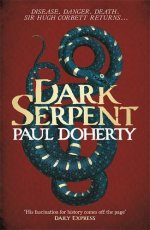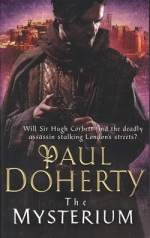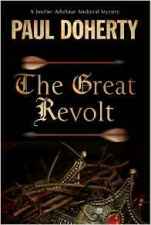 Regular readers of the blog will know how much of a fan I am of Paul Doherty’s work. Traditional mysteries, often with an impossible crime thrown in, set in a variety of time periods, from Ancient Egypt to the nineteenth century. From the Judge Amerotke novels via Persia with Alexander the Great and Ancient Rome with Claudia via medieval England with Sir Hugh Corbett, Brother Athelstan and Kathryn Swinbrooke and into the Tudors with Roger Shallot. And that’s not including the standalone novels or the time-jumping Nicholas Segalla tales.
Regular readers of the blog will know how much of a fan I am of Paul Doherty’s work. Traditional mysteries, often with an impossible crime thrown in, set in a variety of time periods, from Ancient Egypt to the nineteenth century. From the Judge Amerotke novels via Persia with Alexander the Great and Ancient Rome with Claudia via medieval England with Sir Hugh Corbett, Brother Athelstan and Kathryn Swinbrooke and into the Tudors with Roger Shallot. And that’s not including the standalone novels or the time-jumping Nicholas Segalla tales.
He’s about to release his (I think) 107th novel, Dark Serpent, the eighteenth novel featuring Hugh Corbett. It’s his longest running series (although Brother Athelstan has almost caught up) and to celebrate, I asked Paul to do a quick interview with me, and I’m delighted to say that he said yes! (Which is kind of obvious from the title of the post, really) Anyway, without further ado…
 Let’s start off with the upcoming Hugh Corbett novel (out on 25th August from Headline). Corbett is probably the character that you’re best known for writing, but hasn’t been seen since The Mysterium in 2010. What caused the six-year break?
Let’s start off with the upcoming Hugh Corbett novel (out on 25th August from Headline). Corbett is probably the character that you’re best known for writing, but hasn’t been seen since The Mysterium in 2010. What caused the six-year break?
I am not really sure about the 6 year break from the Hugh Corbett novels. I wanted to turn that series darker and I also needed to do extra research for the context in which he lived. I also concentrated on Tenebrae [a ghost story set in Ancient Rome, published as an ebook] and got busy with other projects.
For those who haven’t read a Hugh Corbett mystery before, tell us a little about the character?
 Hugh Corbett is a royal clerk. He had been married before but his wife died. He is now married to the Lady Maeve, a Welsh noble woman, they have two children Edward and Eleanor. He was reared in the West Country and in Essex. He is a royal clerk in the Chancery of the Secret Seal which was based at Westminster. His home is at Leighton, just beyond the Mile End Road and on the borders of the great Epping Forest. Corbett is black haired and olive skinned. He is a mailed clerk which means he has seen military action in Wales and along the Scottish Border. Corbett is based on a real character, John Drokensford
Hugh Corbett is a royal clerk. He had been married before but his wife died. He is now married to the Lady Maeve, a Welsh noble woman, they have two children Edward and Eleanor. He was reared in the West Country and in Essex. He is a royal clerk in the Chancery of the Secret Seal which was based at Westminster. His home is at Leighton, just beyond the Mile End Road and on the borders of the great Epping Forest. Corbett is black haired and olive skinned. He is a mailed clerk which means he has seen military action in Wales and along the Scottish Border. Corbett is based on a real character, John Drokensford  who later became Bishop of Bath and Wells. Drokensford was a very able clerk, he shot to fame by hunting down those who broke into the Royal Treasury when it was based in the Crypt at Westminster Abbey.
who later became Bishop of Bath and Wells. Drokensford was a very able clerk, he shot to fame by hunting down those who broke into the Royal Treasury when it was based in the Crypt at Westminster Abbey.
The Benedictine Monks had been involved in the robbery, thought they were safe because they were clerics. Basically Drokensford told them to get stuffed, he invaded the abbey, found some of the treasure and 100 of the monks were lodged in the Tower. Like Drokensford Corbett can be quite violent and he has his own henchman, Ranulf atte Newgate, who is a clerk in the Chancery of the Green Wax. Ranulf is based on an historical character, he symbolises the personal bodyguard principal henchman.
 After working for Edward I in the previous books, Hugh now finds himself working for Edward II, a king you’ve written about several times before. Given Edward II’s reputation, how long before Hugh starts to find problems in his new working relationship?
After working for Edward I in the previous books, Hugh now finds himself working for Edward II, a king you’ve written about several times before. Given Edward II’s reputation, how long before Hugh starts to find problems in his new working relationship?
Corbett will have trouble with Edward II, he already has! The difference between Edward I and Edward II is that Corbett was very, very wary of the old King. Edward I in his final years was highly unlikeable. Edward II was incompetent but he appears to be a much more congenial character. We know he had a tremendous sense of humour and according to one entry laughed himself sick at the antics of a jester. Edward II was also a man who stood by his friends: Edward I could be very fickle.
 Talking of Edward II, your first book, A Death Of A King, looked at the mystery behind his “death”. You went on to write about a number of other historical mysteries. When you present a solution to these problems, do you lean towards what you personally believe, or what makes a good story?
Talking of Edward II, your first book, A Death Of A King, looked at the mystery behind his “death”. You went on to write about a number of other historical mysteries. When you present a solution to these problems, do you lean towards what you personally believe, or what makes a good story?
I believe it is both: resolving a mystery usually is a good story. What fascinates me is the way academics keep repeating the same explanation and ignore possible alternatives. I mean the evidence for Edward II escaping is fairly strong though I am beginning to lean towards the theory that he escaped, was recaptured and may have been mortally injured in the process.
 Most of your mysteries include at least one impossible crime – often a locked room murder. Is there any particular reason for this?
Most of your mysteries include at least one impossible crime – often a locked room murder. Is there any particular reason for this?
I love the locked room murder mystery and, I think, so does the reader. It also fits hand in glove where someone has been murdered with malice aforethought and the assassin wants to create the most complex obstacles to what really happened.
 Something that’s puzzled me for a while – over the course of writing over one hundred novels, you’ve used no less than six pseudonyms – Paul Harding, C L Grace, Michael Clynes, Anna Apostolou, Ann Dukthas and Vanessa Alexander. Very simply – why?
Something that’s puzzled me for a while – over the course of writing over one hundred novels, you’ve used no less than six pseudonyms – Paul Harding, C L Grace, Michael Clynes, Anna Apostolou, Ann Dukthas and Vanessa Alexander. Very simply – why?
I did this at the recommendation of my publishers and to a certain extent it was because of different “pedigrees” e.g. Vanessa Alexander concentrated on love stories, Ann Dukthas wrote about Segalla the man who never died. Michael Clynes, a series of novels in Tudor times.
 One character of yours that I get asked about more than any others (as if I’m an expert on these things) is Judge Amerotke. Is there any sign of a trip to Ancient Egypt in the future? And what else can we expect to see from you?
One character of yours that I get asked about more than any others (as if I’m an expert on these things) is Judge Amerotke. Is there any sign of a trip to Ancient Egypt in the future? And what else can we expect to see from you?
I must admit I truly miss my journeys to Ancient Egypt,etc. To a certain extent the publisher plays a key role here and they in turn are influenced by readers. Who knows, I am meeting both publishers soon, I will certainly raise the matter with them.
 Many thanks to Paul for taking the time to do this – he’s an exceptionally busy man. Dark Serpent is available from Headline from August 25th and will be reviewed soon on the blog. Paul’s novels are all available as ebooks from Headline as well, with the exception of the Brother Athelstan series which is published by (and is available from) Severn House. If you’d like a recommendation of where to start, then the recent novella The Peacock’s Cry is a good taster and there’s always my Paul Doherty Top Five post (which probably needs updating, but the recommendations still hold strong). There’ll be more from me on Paul’s work soon as well, but those are good starting points.
Many thanks to Paul for taking the time to do this – he’s an exceptionally busy man. Dark Serpent is available from Headline from August 25th and will be reviewed soon on the blog. Paul’s novels are all available as ebooks from Headline as well, with the exception of the Brother Athelstan series which is published by (and is available from) Severn House. If you’d like a recommendation of where to start, then the recent novella The Peacock’s Cry is a good taster and there’s always my Paul Doherty Top Five post (which probably needs updating, but the recommendations still hold strong). There’ll be more from me on Paul’s work soon as well, but those are good starting points.

Excellent stuff, more Doherty is always good (no idea how he manages it though) – thanks chum.
LikeLike
[…] Despite this, the blog’s been busy, with three film reviews (and could the people who keep sending me emails concerning marketing their superhero sh*te, please sod off – just read the rest of the blog and work out if I want to sell Captain America underpants) and, most importantly to me, interviews with two of the writers who will automatically make it into any “Top Five Writers” post, regardless of what mood I’m in when I write the list – Michael Jecks and Paul Doherty. […]
LikeLike
[…] Wassmer, Martin Edwards, L C Tyler, Michael Jecks and Paul Doherty, all of whom were willing to do a little interview with me on the blog. Much appreciated, although […]
LikeLike